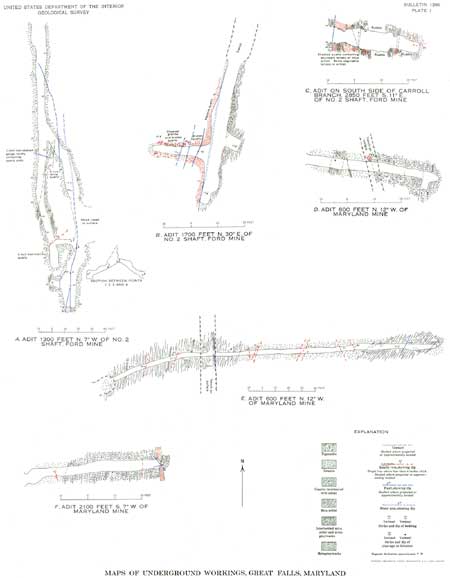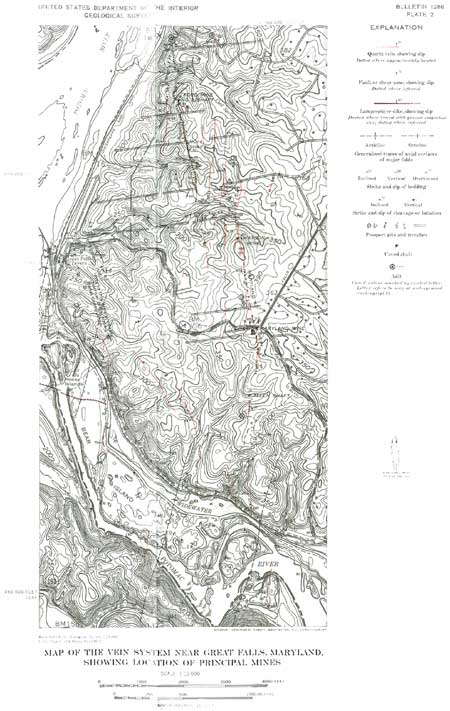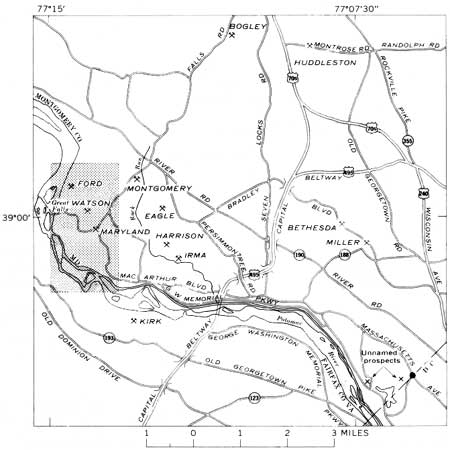
|
Geological Survey Bulletin 1286
Gold Veins Near Great Falls, Maryland |
INTRODUCTION
During the past 100 years more than 5,000 ounces of gold, valued at more than $150,000, have been produced in Maryland, almost all from small mines in the southern part of Montgomery County (fig. 1). These mines have been described in a number of popular articles (Ulke, 1939; Shosteck, 1953; Ostrander, 1940; Zodac, 1947; Ingalls, 1960) and have attracted considerable attention among mineral collectors and historians. Emmons (1890) and Weed (1905) briefly examined some of the deposits and published short descriptions, but since their work no systematic geologic study of any of the deposits has been made.
Active mining in the area ended before World War II, and many of the workings have long since been obliterated. Near Great Falls, however, an extensive group of workings along one of the most productive vein systems is still well preserved (fig. 2). Several miles of prospect trenches, dozens of shallow pits, and a few accessible underground openings (pl. 1) afford an unusually good opportunity to examine and map the veins (pl. 2), and nearby exposures along the Potomac River allow detailed study of the wallrocks. A preliminary paper summarizing the results of our study of these deposits has already been published (Reed and Reed, 1967); the present paper is a modified and expanded version of our earlier discussion.

|
| FIGURE 2.—Aerial photograph showing surface workings along part of Great Falls vein system. For location of area, see plate 2. Note pits and trenches along Ford vein and vein to west. Lines of trees in open field east of Ford vein mark outcrops of other quartz veins. Long east-west prospect trenches (T) date from exploration work during 1915-18. |

|
| PLATE 1.—Maps of underground workings, Great Falls, Maryland. (click on image for an enlargement in a new window) |

|
| PLATE 2.—Map of the vein system near Great Falls, Maryland, showing location of principal mines. (click on image for an enlargement in a new window) |
Many of the workings near Great Falls lie within the George Washington Memorial Parkway, which is administered by the U.S. National Park Service. Prospecting is prohibited in the parkway, and specimens may be collected only with the written approval of the superintendent. Prospecting or collecting on adjacent private lands, of course, requires the consent of the owners. Most of the underground workings are partly caved and some are decidedly unsafe. They should be entered only with great caution!
We would like to express our appreciation to Dr. William L. Hendrickson, chief of interpretation, George Washington Memorial Parkway, for his interest and encouragement of our study; to Mr. Paul H. Keller, seasonal naturalist at Great Falls Park, for his assistance in the field; and especially to Mr. Edgar T. Ingalls of Potomac, Md., former underground foreman at the Maryland mine, who provided much firsthand information on the history and development of the Great Falls gold deposits and kindly allowed us to examine and photograph his collection of gold specimens. Our study was greatly facilitated by a comprehensive bibliography and file of newspaper clippings, extracts of published articles, mint returns, and field notes prepared by Nancy C. Pearre, formerly of the U.S. Geological Survey.
| <<< Previous | <<< Contents >>> | Next >>> |
bul/1286/intro.htm
Last Updated: 28-Mar-2006
